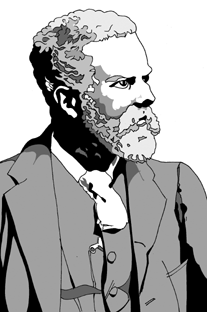 |
 |
|||
|
|
Alfred Waterhouse was the son of wealthy mill-owning quaker parents. Born in Liverpool, he was educated at the quaker Grove School in Tottenham (Middlesex). Apprenticed as an architect to Richard Lane, he spent much of his youth travelling throughout Europe and studied in France, Italy and Germany. Upon his return to England, Alfred set up his own architectural practice in Manchester. During his twelve years there, his skills were in great demand, especially for the many new public buildings that the city authorities commissioned in the High Victorian era. For Waterhouse's dozen staff were able to produce large quantities of high-quality drawings with both speed and efficiency. He won the competition to build the Assize Courts in 1859 and other buildings soon followed: the original Owens Park Building (now the University of Manchester), Strangeways Prison, the Refuge Assurances Building (now the Palace Hotel) and the National Provincial Bank. He also erected fine buildings for the City of Liverpool, such as the Lime Street Station Hotel (1868-71). The most notable of Waterhouse's Northern structures, however, was the new Manchester Town Hall (1868-77). Here, a triangular site called for innovative and original ideas, the difficulties of which only Waterhouse's clever design were able to overcome. The result is the striking Neo-Gothic Building of today, always admired by the general public as well as the architectural community. Eventually, Waterhouse moved south to London, where he designed the Royal Institution of Chartered Surveyors off Parliament Square and the Guilds' College in South Kensington (Middlesex). He became most renowned, however, for the magnificent Natural History Museum (1873-81), also in South Kensington. This modified Romanesque style building is notable for its pioneering revival of terra-cotta - used on the facing in yellow, red and light blue - brought about by Alfred's concern for hard wearing surface materials. He also created a number of Oxbridge Colleges - Balliol College (Oxford) and Pembroke College (Cambridge) - and Prudential Assurance Buildings, such as those in Holborn, Southampton and Leeds. Financially speaking, Waterhouse was probably the most successful of all Victorian architects. His planning skills were recognised at an early stage, but appreciation of his stylistic achievements has taken longer. Influenced by both Ruskin and Pugin, as well as the more practical approach of George Gilbert Scott, he developed his own slant on the composition of forms and a predilection for simple bold ornamentation to equal the growing scale of his designs. Though expert within Gothic and free Renaissance styles and having a preference for the Neo-Romanesque, Waterhouse did not limit himself to a single architectural look. He made a distinction between moulded or carved ornamentation on plain stone and naturally decorative materials, like veined marble, which he usually left unembellished. Such sensitive treatment of materials verged upon the aspirations of the Arts and Crafts Movement, but he always acknowledged construction as an industrial process. His buildings have characteristically bold and picturesque outlines and sound planning, with especial awareness of the urban skyline. Amongst his many honoured positions, he was President of the Royal Institute of British Architects from 1888 to 1891. Though a most prolific architect, best known for his large scale public and commercial buildings, Waterhouse was also a furniture designer and painter and built many smaller domestic buildings. For example, his own residences: Barcombe Cottage (at Fallowfield in Manchester 1864), Foxhill House (at Whiteknights in Earley, Berkshire 1868) and Yattendon Court (also in Berkshire 1877). This latter county was his home in his later years and he was well known for designing such local buildings as the town hall in Reading. He erected a second house on the Whiteknights estate - Whiteknights House - for his father and was much involved with the adjoining school of Leighton Park. He eventually died in Yattendon in 1905.
|
|||
| © Nash Ford Publishing 2003. All Rights Reserved. | ||||



 Alfred
Waterhouse (1830-1905)
Alfred
Waterhouse (1830-1905)